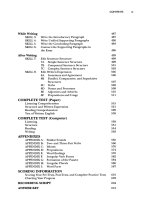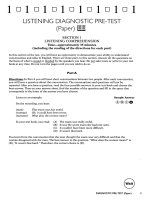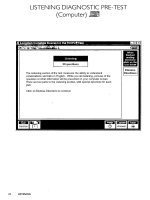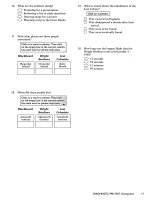colloquial arabic (levantine) the complete course for beginners
Bạn đang xem bản rút gọn của tài liệu. Xem và tải ngay bản đầy đủ của tài liệu tại đây (577.37 KB, 154 trang )
COLLOQUIAL
ARABIC
(LEVANTINE)
The Colloquial Series
Series adviser: Gary King
The following languages are available in the Colloquial series:
Albanian Korean
Amharic Latvian
Arabic (Levantine) Lithuanian
Arabic of Egypt Malay
Arabic of the Gulf Mongolian
and Saudi Arabia Norwegian
Basque Panjabi
Bulgarian Persian
*Cambodian Polish
*Cantonese Portuguese
*Chinese Portuguese of Brazil
Croatian and Serbian Romanian
Czech *Russian
Danish Slovak
Dutch Slovene
Estonian Somali
Finnish * Spanish
French Spanish of Latin America
German Swedish
Greek * Thai
Gujarati Turkish
Hindi Ukrainian
Hungarian * Vietnamese
Indonesian Welsh
Italian
Japanese
Accompanying cassette(s) (*and CDs) are available for all the above titles. They
can be ordered through your bookseller, or send payment with order to
Routledge Ltd, ITPS, Cheriton House, North Way, Andover, Hants SP10 5BE,
or to Routledge Inc., 29 West 35th Street, New York NY 10001, USA.
COLLOQUIAL CD-ROMs
Multimedia Language Courses
Available in: Chinese, French, Portuguese and Spanish
Forthcoming: German
COLLOQUIAL
ARABIC
(LEVANTINE)
Leslie J.McLoughlin
Routledge
London and New York
First published in 1982
by Routledge & Kegan Paul Plc
Routledge is an imprint of the
Taylor & Francis Group
This edition published in the Taylor & Francis e-Library, 2003.
© Leslie J.McLoughlin 1982
All rights reserved. No part of this book may be reprinted
or reproduced or utilized in any form or by any electronic,
mechanical, or other means, now known or hereafter
invented, including photocopying and recording, or in any
information storage or retrieval system, without permission
in writing from the publishers.
British Library Cataloguing in Publication Data
McLoughlin, Leslie J.
Colloquial Arabic (Levantine).
1. Arabic language—Spoken Arabic
2. Arabic language—Grammar
I. Title
492´.783421 PJ6307 80–42071
ISBN 0-203-13615-2 Master e-book ISBN
ISBN 0-203-17570-0 (Adobe eReader Format)
ISBN 0-415-05107-X (Print Edition)
ISBN 0-415-01854-4 (cassette)
ISBN 0-415-00073-4 (book and cassette course)
v
CONTENTS
ABBREVIATIONS vii
INTRODUCTION 1
PART ONE THE LESSONS 13
1 Nouns and adjectives; basic sentences 13
2 Possession and pronouns 18
Appendix: Numbers 21
3 Verbs, word order and demonstratives 24
4 Verbs, conjunctions and elatives 33
5 Participles 40
6 Hollow verbs and ‘to be able’ 44
7 Verbs, defective and doubled 50
8 Assimilated verbs, conjunctions and ‘for’ 58
9 Relative pronouns, verbal nouns and possession 63
10 More verbs, verbal phrases and whenever/whoever 69
11 Conditional sentences 73
12 Idioms 76
13 Terms of address and reference 86
14 Proverbs 92
15 Courtesy expressions for various occasions 97
16 A story 101
17 A miscellany 105
18 Concepts in society 112
19 Abuse 117
vi CONTENTS
PART TWO APPENDICES
Key to exercises 121
Grammar, indexed by lesson 127
Vocabulary 129
Bibliography 145
ABBREVIATIONS
adj. Adjective
BRP British Received Pronunciation
c. Common (of gender)
CA Classical Arabic
coll. A. Colloquial Arabic
f. Feminine
lit. Literally
m. Masculine
n. Noun
pl. Plural
prep. Preposition
pron. Pronoun
sing. Singular
vb Verb
v.n. Verbal noun
1
INTRODUCTION
Arabic is the language of daily communication for between 150 and
200 million people, and the language of worship for many hundreds
more millions of Muslims. It is the original language of the Koran,
which in Muslim belief is incomparably excellent, since it is the
direct word of God (kalaam allaah). Arabic is the language of prayer
for all Muslims, and the language of the muezzin who summons the
faithful to prayer the world over five times daily. It is now an official
working language in the UN and many international agencies. Its
script is used in many other languages—Persian, Ottoman Turkish
and Urdu among them—and since the Koran is possibly the world’s
best selling book the Arabic script may well be the second most
used script after Latin. The Arabic written language is almost
completely uniform throughout the Arab world. Moreover the
language of radio and television is uniform to the same extent, since
it is simply the written word of modern Arabic being read aloud.
There is a direct line of descent from classical Arabic, the language
of the Koran, to modern Arabic; so that across 1,400 years (in the
Islamic calendar) the script is recognizably the same, the grammar has
changed remarkably little (by comparison with, for example, German
or English) and even the vocabulary has shown an astonishing integrity
and consistency. It is the Koran which has preserved the essence of
written Arabic, and it is also the elevated status accorded to the
original language of Islam which has prevented the Arabic dialects
from becoming as far apart from each other as the dialects of Latin.
Whereas Italian and French are not now mutually comprehensible,
the speakers of dialects of Arabic over an enormous area can
understand each other. Peasants from Muscat and Morocco
INTRODUCTION2
respectively would certainly have problems with each other’s dialects,
but even peasants and certainly educated people throughout the
Peninsula, the Levant, Iraq, Egypt, the Sudan and some parts of N.
Africa can make themselves understood to each other without
necessarily resorting to classical Arabic.
Within the Levant (historical Syria, Jordan and Lebanon) there is,
if not linguistic homogeneity, at least clearly visible evidence of close
similarity between the many dialects. The differences are what one
would expect. A Sidon (Lebanon) fisherman will use different
metaphors from those of a Syrian from the Jebel Druze; because of
close community ties over long historical periods villages tend to
preserve distinctive features of vocabulary and phonology. *
This introductory manual aims to present those features of the
language which would be acceptable throughout the Levant area.
The speech presented is not, on the one hand, the dialect of any
particular village or area; nor is it, on the other, a debased classical
form spoken by no one in particular. The aim is to present a natural
form of speech, which is acceptable and at the same time idiomatic
and correct.
An Arabic proverb says ‘A new language is a new man’ and, among
other things, this means that a non-Arab approaching Arabic has to
be ready to understand (if not necessarily to imitate) different attitudes
and perspectives. Westerners are not in everyday speech given, as
Arabs are, to quoting poetry, ancient proverbs and extracts from holy
books. Nor are they wont to exchange fulsome greetings. This is to
say nothing of the different attitudes to physical contact and proximity,
as well as to relations between the sexes. It is, however, essential to
understand not only the grammar and vocabulary of the Arabic of
this area but also the underlying attitudes and assumptions.
Perhaps the greatest difference between the Levantine approach
to language and that of westerners is that Levantines, like most Arabs,
take pleasure in using language for its own sake.** The sahra (or
evening entertainment) may well take the form of talk alone, but
*This is after all the area which gave the world the concept of a shibboleth, and
this same feature (s/sh) still distinguishes Levant dialects from each other (sajara/
shajara; tree).
**But in a way totally different from other Arabic speakers: five minutes on the
streets of Cairo reveal attitudes to life and language totally different from those of
Syria.
INTRODUCTION 3
talk of a kind forgotten in the west except in isolated communities
such as Irish villages or Swiss mountain communities—talk not merely
comical, tragical, historical/pastoral, etc but talk ranging over poetry,
story-telling, anecdotes, jokes, word-games, singing and acting. It is
no accident that Arabic has a verb which means ‘to chat to someone
in the evening’ and that a common name is Samir (f. Samira) meaning
‘one with whom one chats in the evening’. The moral for the non-
Arab is that if one can adjust to these different attitudes to language,
and understand what is going on, one can discover whole layers of
Arab life which must remain unsuspected to those who know no
Arabic or who, knowing some, remain attached to (for example) the
belief that only classical Arabic is a fit object of study. The present
writer takes the view that a real understanding and appreciation of
colloquial Arabic can only expand a student’s knowledge of classical
Arabic. A student who understood all the allusions to poetry, proverbs
and religion to be heard on a day’s march in the Levant would be far
beyond doctoral standards in terms of university study. *
This manual attempts to give some insight into aspects of colloquial
Arabic other than syntax and vocabulary: in addition to twelve lessons
on these subjects there are lessons on idioms, greetings, ritual language,
terms of address and reference, proverbs, even on abuse. A multi-
media approach would be necessary to do justice to a communicative
approach to colloquial Arabic** (perhaps to any language) but the
present volume, it is hoped, will, by presenting information in separate
‘packages’ on the printed pages, prepare the student’s approach to
mastering this most fascinating language.
*Lebanese Arabic in particular is much maligned by some orientalists.
In fact a study of its vocabulary reveals a very high percentage of
classical vocables.
**This manual has, perforce, to omit an essential element in everyday
Levantine communication, namely hand gestures. An illustrated
dictionary of the meanings of some hundreds of gestures could be
(indeed, once was) compiled. These differ from Mediterranean hand
gestures (with which they show some features) in that they not only
reinforce meaning but can also be used to hold meaningful
conversations across a distance.
INTRODUCTION4
THE STRUCTURE OF ARABIC
The following are brief notes on how Arabic works, taking ten
broad features common to both written and spoken Arabic.
1 Arabic is a Semitic language (unlike Turkish and Persian), hence
the similarity to Arabic of Hebrew phrases from the Bible, e.g. Matt.
27:46: ‘Jesus cried with a loud voice, saying, Eli, Eli, lamma sabachthani?
that is to say, My God, my God, why hast thou for-saken me?’
2 Semitic languages are distinguished by the triliteral root
system. The consonants k-t-b imply something to do with writing.
The addition of prefixes, infixes and suffixes generates words
connected with writing.
3 The root and pattern system in Arabic is highly developed
and, being on the whole consistent and predictable, can be used
by a foreign student to guess meanings of new words and increase
vocabulary. Thus, from k-t-b:
Pattern Word Remarks
1 ma/—a- maktab Office, study, bureau, desk
Pattern always means ‘place of…’
2 -aa-i- kaatib Clerk, writer, author
Pattern always means the active
participle or doer of the action
3 ma oo- maktoob Letter
Pattern always means the passive
participle
4 -aa-a- kaatab To correspond with someone
Form III derived verb, usually means
to do the action to someone
5 mu-aa-i- mukaatib Correspondent
Active participle of (4) above
4 Predictability Arabic has almost complete predictability in its patterns
(cf. English: light/lit; fight/fought; sight/sighted). Past-tense verbs conjugate
with suffixes, for example, which are invariable for all verbs.
5 Consistency in spelling
(a) Words can be spelled correctly once the sound is known
correctly. Not for Arabic the complexities of English: seen/
scene; bean/been etc.
INTRODUCTION 5
(b) The name of the consonant gives the consonant’s pronunciation.
Haa’ is the name of the sound registered by H (cf. English:
aitch=h).
6 Economy
(a) Arabic has only two tenses, past and non-past.
(b) Arabic has basically only three short vowels (a, i and u), three
long (aa, ee and oo) and two diphthongs (ay and aw).
(c) In classical Arabic the short vowels do heavy morphological
duty for verb endings, case endings and pronoun distinction,
in ways which are clearly related, for example a final /i/ or /
ee/ means you, feminine singular, in both verbs and pronouns.
(d) In colloquial Arabic the same applies, but even more so:
colloquial has almost no case endings, and verb suffixes are far
fewer than in classical.
7 Simplicity Particularly in colloquial Arabic, sentence structure is very
simple: for example, equational sentences have no is/are. Furthermore,
Levantine Arabic like all Arabic dialects is much given to expressing a
great deal in highly truncated sentences and phrases and even single
words. (Cf. Egyptian multi-purpose use of the word for yes!)
8 Stress patterns The place of the stress—or prominence—in a
word is almost completely determined by fixed rules. In broad terms
the stress falls on the first syllable except when the word has a long
syllable. Then the stress falls on the nearest long syllable to the end
of the word.*
9 Formality Colloquial Arabic has many ritual or formal phrases in
greeting, salutation etc. (Beware of thinking, however, that the language
is cabalistic!)
10 Intonation Particular attention should be paid by students to
native speakers’ intonation: a wrong intonation is one of the clearest
markers of a foreign accent.
TRANSCRIPTION AND PRONUNCIATION
Systems of transliteration seem to vary only in degrees of repulsiveness.
No one system is satisfactory to all, and the general reader is often
*A long syllable is one with a long vowel or diphthong or a short vowel followed
by two consonants.
INTRODUCTION6
deterred by an excessively scrupulous attempt to render phonetic
differences.
The system employed in this book uses only the symbols found
on an ordinary typewriter. In the writer’s experience most of the
apparent difficulties of using transliteration disappear when use is
made of a recording of the text (see How to use the book).
Introduction to Arabic pronunciation
1 Consonants and vowels The table below aims to guide the
beginner with a mixture of technical terms and layman’s language.
The recordings should also be used freely.
2 Stress Arabic stress rules are quite different from English, and
failure to observe this is one of the principal features of a foreign
accent.
(a) short syllables have short vowels;
(b) long syllables have either long vowels or a diphthong; or a short
vowel followed by two consonants;
(c) in words with long and short syllables the stress falls on the
nearest long syllable to the end of the word;
(d) otherwise the stress is on the first syllable.
Examples: mu’Hamw mad; bayróot; ána.
3 Intonation One of the principal features distinguishing Levantine
dialects one from another, and all from English, is the intonation, the
rise and fall of the voice. Students should note different intonation
patterns most carefully. A wrong intonation pattern is another common
feature of a foreign accent.
4 Junction and elision The student should note how words ‘run
together’, in order to avoid sounding too foreign.
A hyphen is intruded as a guide to pronunciation as follows:
between /s/ and /h/ when these symbols represent separate
consonants, for example,’as-hal (easy). Therefore when /sh/ is written
with no hyphen the sound is as in English ship. Similarly for k-h/kh,
t-h/th, d-h/dh and g-h/gh.
An asterisk (*) in the table below indicates that the pronunciation
of Levantine Arabic (in one or other dialect) may differ markedly
from that of classical Arabic.
INTRODUCTION 7
Please note
For most occurrences in classical Arabic of the unvoiced uvular plosive
(qaaf: /q/ in transliteration) the symbol /’/ is used (i.e. the symbol for
the glottal stop). Most Levantine dialects regularly make this
‘conversion’ from classical Arabic, but the student should note that:
1 Bedouin throughout the area use /g/ for /q/,
2 the Druzes systematically maintain /q/,
3 certain words always retain the classical /q/: al-qur’aan (Koran)
and al-qaahira (Cairo).
INTRODUCTION8
INTRODUCTION 9
INTRODUCTION10
Pronunciation exercises
These are taken from proper names, i.e. names of persons and places
of relevance to the modern Arabic and Islamic worlds, and to the
Levant. The tape recordings should be used freely.
saqaTra qubruS
dimashq SaaliH
Hasan Husayn
sa9eed su9ood
najeeb tawfeeq
saleem saalim
meekhaa’eel faaDil
kareem baheej
’ibraaheem fareed
wadee9 9abd un-naaSir
9abd us-salaam 9aarif 9abd ul-laTeef baghdaadee
’aHmad shuqayree ’aHmad 9abd ullah
muHammad 9abd us-salaam 9alee 9abd ul-laTeef
9abd ul-kareem qaasim 9abdul-Hakeem 9aamir
’ash-shaykh saalim ’aS-SabaaH ’ ameer al-kooayt
maHmood 9abd ul-waaHid noor ud-deen 9abd ul-
haadee SalaaH ud-deen ’al-ayyoobee muSTafa kamaal
(Saladin) naSree shams ud-deen
muHammad salmaan fareed al-’aTrash
9uthmaan Husayn maHmood ’alhaashimee
’iHsaan Saadiq najaat’aS-Sagheera
INTRODUCTION 11
naaZim ’al-qudsee fareed shawqee
sameera tawfeeq 9umar ’ash-shareef
’aHmad shawqee Saa’ib salaam
muHammad 9abd ul-wahhaab yaasir 9arafaat
kaamil ’al-’as9ad
HOW TO USE THE BOOK
Without a teacher
There are scores of possible ways of using a combination of the
Arabic text, the translation or key and the sound recording of the
Arabic, but among the possibilities are the following four step-by-
step procedures for exercises and dialogues:
1 Read the English; say the Arabic; hear the Arabic recording; repeat
the Arabic.
2 As 1 and then: play your own voice recording; play the Arabic;
correct where necessary.
3 Hear the Arabic recording (at any point, i.e. in random fashion);
write the translation; check and correct where necessary.
4 Use the recordings for memorizing vocabulary; test yourself by
covering up the Arabic version and saying the Arabic; check from
the recording.
All sections of text which are on the cassette are marked
in the margin.
With a teacher
The teacher will want to use his own methods based on experience,
but the following suggestions may be useful.
1 Ten drills based on the sentences and dialogues: repetition;
inflexion; replacement; restatement; completion; transposition;
expansion; contraction; transformation; integration. (See the author’s
Course in Colloquial Arabic, Beirut, 1974, pp. 12–14)
Of these, transformation is particularly valuable for Arabic; a
given sentence can be changed for tense, negativeness, positiveness,
interrogative etc.
2 Random comprehension practice The teacher may use the
Arabic of the dialogues or the exercises for rapid-fire testing of
INTRODUCTION12
comprehension (in random order, preferably) or for eliciting the
correct response.
3 Action and movement The teacher may have the student(s) act
out the dialogues with appropriate exits and entrances when necessary.
4 Recapitulation The student(s) may be asked to re-tell the story
of the dialogues and the anecdote in Lesson sixteen.
5 Vocabulary testing This can be done Arabic-English or English-
Arabic using the lists in each chapter or, at a later stage, the vocabularies
at the end of the book.
13
PART ONE
THE LESSONS
LESSON ONE
NOUNS AND ADJECTIVES;
BASIC SENTENCES
FIRST, THE GOOD NEWS
Equational sentences (e.g. The teacher/he…is…)
You can communicate a great deal in perfectly correct Arabic (spoken
and written) without using a single verb.
1 The present tenses of to be and to have are not in the form of
conjugated verbs in Arabic (see Lesson two for to have). In fact
there is no need normally to say is/are.
2 The negative is formed by using one word (mush)
systematically for nouns, adjectives and adverbs.
3 The interrogative is formed by simply changing the
intonation of the voice. Compare English: They are not here,
Aren’t they here?
Examples
Salim is here—saleem hawn
Salim is not here—saleem mush hawn
Is Salim here?—saleem hawn?
Is Salim not here?—saleem mush hawn?
Karim is Lebanese—kareem lubnaanee
Karim is not Lebanese—kareem mush lubnaanee
Is Karim Lebanese?—kareem lubnaanee?
Is Karim not Lebanese?—kareem mush lubnaanee?
LESSON ONE
14
Note The ‘Karim’ sentences illustrate that all adjectives may be used
as nouns. Indeed the classical grammarians say that the whole of
Arabic grammar may be summed up in three parts: nouns, verbs and
particles.
SUBJECT PRONOUNS
Singular Plural
1 c. ’ana ’iHna
2 m ’inta ’intoo
2 f. ’intee ’intoo
3 m. huwa hum
3 f. hiya hum
Note (1) You and I—’ana oo ’inta. (2) Many dialects use a different
compound form of the subject pronouns (see below, in Lesson two,
‘Possession’): You and I—’ana oo iyyaak.
Examples
They are Jordanians—hum ’urdunee-een
We are Syrians—’iHna sooree-een
They are the Lebanese girls—hum ’il-banaat il-lubnaanee-een
AGREEMENT
Adjectives and verbs agree in gender and number with their noun or
pronoun subjects in Arabic. On the other hand…
1 There is no indefinite article, let alone a declined one as in
many European languages.
2 The definite article does not change for gender or number.
3 Plural non-humans are regarded as feminine singular for the
purposes of grammatical agreement.
GENDER
The feminine adjective is formed in most cases by simply adding /a/
: shaikh, shaikha; sulTaan, sulTaana; lubnaanee, lubnaaneea; urdunee,
urduneea.
LESSON ONE
15
Adjectives formed from names, such as lubnaan/lubnaanee, bayroot/
bayrootee, are called nisba adjectives (meaning relationship). When made
feminine (by adding /a/) they double the /ee/ sound. The feminine
nisba ending will henceforth be transcribed-iyya.
Noun Adjective Feminine adjective
lubnaan lubnaanee lubnaaniyya
bayroot bayrootee bayrootiyya
dimashq dimashqee dimashqiyya
Examples
The boy is Syrian—’il-walad sooree
The girl is Syrian—’il-bint sooriyya
The boy is a Muslim—’il-walad muslim
The girl is a Muslim—’il-bint muslima
Conversely, most nouns ending in /a/ are feminine.
NUMBER
1 Arabic has a form for dual (two of anything) formed by
adding -ayn (as in Bahrain, Alamain etc,):
The two boys are here—’il-waiadayn hawn
The two girls are here—’il-bintayn hawn
2 The most common plural formula (the ‘sound’ one) is that
composed of the adjective/noun plus -een:
a Syrian—sooree (NB no indefinite article in Arabic)
the Syrians—’is-sooree-een
(Plurals formed otherwise—see Vocabulary—are called broken
plurals.)
3 In colloquial Arabic the feminine plural ending (-aat) is not
extensively used:
The girls are Syrian—’il-banaat sooree-een
4 The attributive adjective (e.g. ‘the Syrian girls’) must also be
definite:
the Jordanian girls—’il-banaat ’il-’urdunee-een
LESSON ONE
16
5 Usually a dual noun (especially with humans) will, in
colloquial Arabic, have a plural adjective:
the two Lebanese girls—’il-bintayn ’il-lubnaanee-een
THE IDAFA OR CONSTRUCT
This feature of Arabic has no equivalent in English, but the rules can
be learned from simple, well-known examples.
The Arabic name Dar es Salaam means
‘
the abode of peace’. Notice
that the first definite article is not used.
Rule 1 in the structure the…of the…the first definite article is not
found:
the book of the boy—kitaab ’il-walad
Rule 2 the construct, if longer, removes all but the final definite
article:
the book of the son of the teacher—kitaab ’ibn il-mu9allim
Rule 3 there is no ‘apostrophe s’ in Arabic. ‘The boy’s book’ must
be rendered ‘the book of the boy’.
VOCABULARY
Arab—9arabee (pl. 9arab)
boy, son—walad (pl. ’awlaad)
son—’ibn (pl. ’abnaa)
girl, daughter—bint (pl. banaat)
ambassador—safeer (pl. sufaraa’)
teacher—mu9allim (pl. -een)
book—kitaab (pl. kutub)
Lebanese—lubnaanee (pl. -een)
Syrian—sooree, shaamee (pl. -een)
Jordanian—’urdunee (pl. -een)
Palestinian—filisTeenee (pl. -een)
French—faransaawee (pl. -een)
English—’ingleezee (pl. ’ingleez)
American—’amreekaanee (pl. ’amreekaan)
foreigner—’ajnabee (pl. ’ajaanib)









